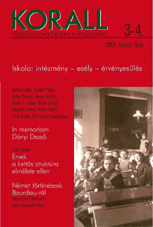A tudáselit középiskolái. A két világháború közötti tudáselit középszintű iskoláztatása
Secondary schools of the intellectual elite. Secondary schooling of the intellectual elite between the two World Wars
Author(s): Gábor Kende, I. Gábor KovácsSubject(s): History
Published by: KORALL Társadalomtörténeti Egyesület
Keywords: social history; social history of education; 19th–20th centuries; Hungary; secondary schooling of the intellectual elite
Summary/Abstract: The study presents data concerning the secondary education of the inter-war intellectual elite. We are familiar with the high schooling data of 1252 members, covering 83,3% of the elite that counted 1502 persons on the whole. The elite group studied in the high schools of historical Hungary prior to the Treaty of Trianon, mainly between the years 1860 and 1920. This essay is, among others, concerned with the methodological problem of dealing with the individual choice of changing schools. Moreover, it presents the ranking of elite schools that released the most elite members and presents the changes, modifications in ranking according to the four age-groups of the elite, and to certain sub-patterns (university professors, members of the Academy etc.) as well. The study also pays attention to the shifting role of schools in the traditional school-towns and the rising regional centres. Furthermore, it also enlarges upon the proportional modification of denominational schools and the newly founded, proliferating state schools in elite schooling. Finally, it analyses how much share certain school types had in education and also deals with the question of the place of birth, taken both in a narrow and a broad sense. As facts show, to a different extent however, but almost the entire high school network took part in elite schooling. The role of Budapest, with a proportion of one third, is certainly outstanding and determining. Still, the fact that there were schools in 132 of all settlements in the country, whose graduates could become part of the national intellectual elite, suggests a well expanded network.
Journal: Korall - Társadalomtörténeti folyóirat
- Issue Year: 2001
- Issue No: 3-4
- Page Range: 170-187
- Page Count: 18
- Language: Hungarian

